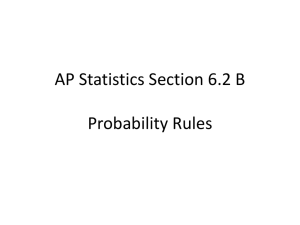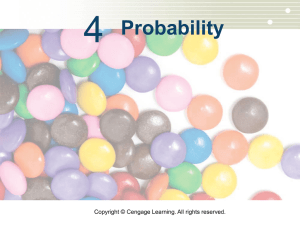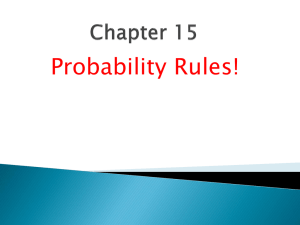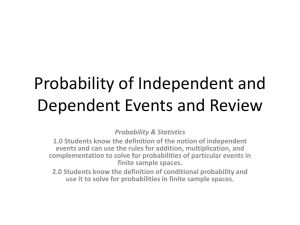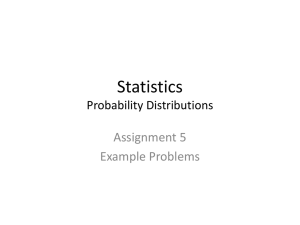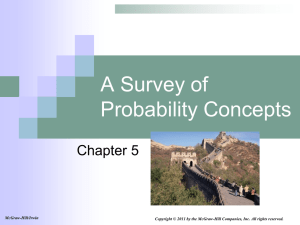Document
advertisement
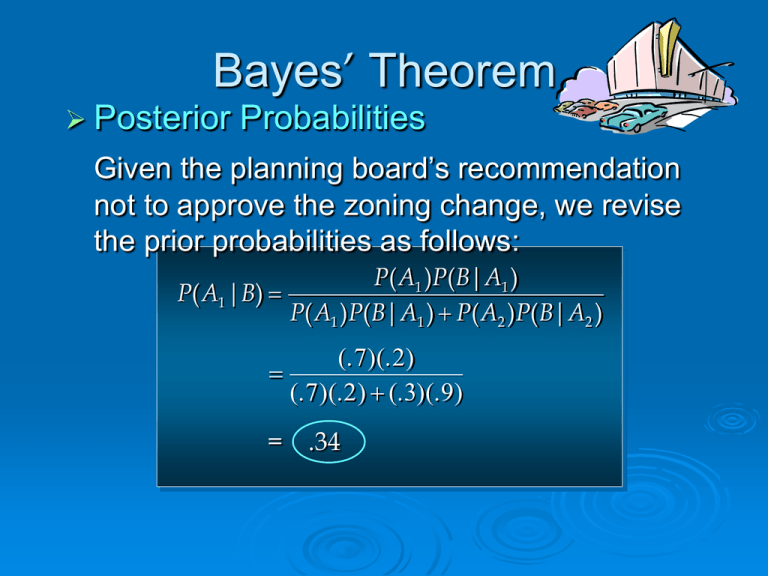
Bayes’ Theorem Posterior Probabilities Given the planning board’s recommendation not to approve the zoning change, we revise the prior probabilities as follows: P( A1 )P( B| A1 ) P( A1 |B) P( A1 )P( B| A1 ) P( A2 )P( B| A2 ) (. 7)(. 2) (. 7)(. 2) (.3)(.9) = .34 Bayes’ Theorem Conclusion The planning board’s recommendation is good news for L. S. Clothiers. The posterior probability of the town council approving the zoning change is .34 compared to a prior probability of .70. Tabular Approach Step 1 Column 1 the - Thefollowing mutually exclusive for which Prepare threeevents columns: posterior probabilities are desired. Column 2 - The prior probabilities for the events. Column 3 - The conditional probabilities of the new information given each event. Tabular Approach (1) (2) (3) Prior Conditional Events Probabilities Probabilities Ai P(Ai) P(B|Ai) A1 A2 .7 .3 1.0 .2 .9 (4) (5) Tabular Approach Step 2 Column 4 Compute the joint probabilities for each event and the new information B by using the multiplication law. Multiply the prior probabilities in column 2 by the corresponding conditional probabilities in column 3. That is, P(Ai IB) = P(Ai) P(B|Ai). Tabular Approach (1) (2) (3) (4) Prior Conditional Joint Events Probabilities Probabilities Probabilities Ai P(Ai) P(B|Ai) P(Ai I B) A1 A2 .7 .3 1.0 .2 .9 (5) .14 .27 .7 x .2 Tabular Approach Step 2 (continued) We see that there is a .14 probability of the town council approving the zoning change and a negative recommendation by the planning board. There is a .27 probability of the town council disapproving the zoning change and a negative recommendation by the planning board. Tabular Approach Column 4 Step 3 Sum the joint probabilities. The sum is the probability of the new information, P(B). The sum .14 + .27 shows an overall probability of .41 of a negative recommendation by the planning board. Tabular Approach (1) (2) (3) (4) Prior Conditional Joint Events Probabilities Probabilities Probabilities Ai P(Ai) P(B|Ai) P(Ai I B) A1 A2 .7 .3 1.0 .2 .9 .14 .27 P(B) = .41 (5) Tabular Approach Step 4 Column 5 Compute the posterior probabilities using the basic relationship of conditional probability. P( A | B) P( Ai B) i P( B) The joint probabilities P(Ai I B) are in column 4 and the probability P(B) is the Tabular Approach (1) (2) (3) (4) (5) Prior Posterior Conditional Joint Events Probabilities Probabilities Probabilities Probabilities Ai P(Ai) P(Ai |B) P(B|Ai) P(Ai I B) A1 A2 .7 .3 1.0 .2 .9 .14 .27 P(B) = .41 .14/.41 .3415 .6585 1.0000 Homework P142-2 P 143-6,9,10 P146-15,17 P152-23 P153-28 P158-30,33 P165-39,42 End of Chapter 4

